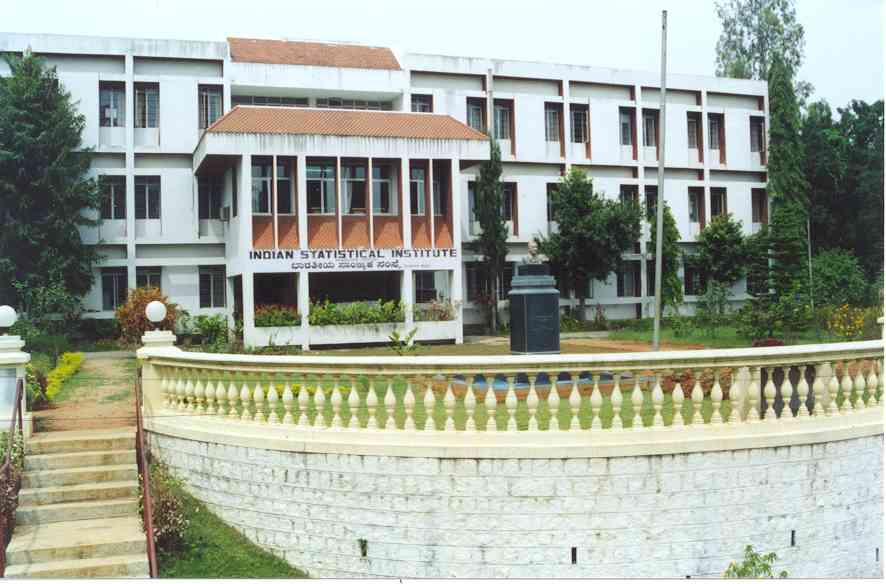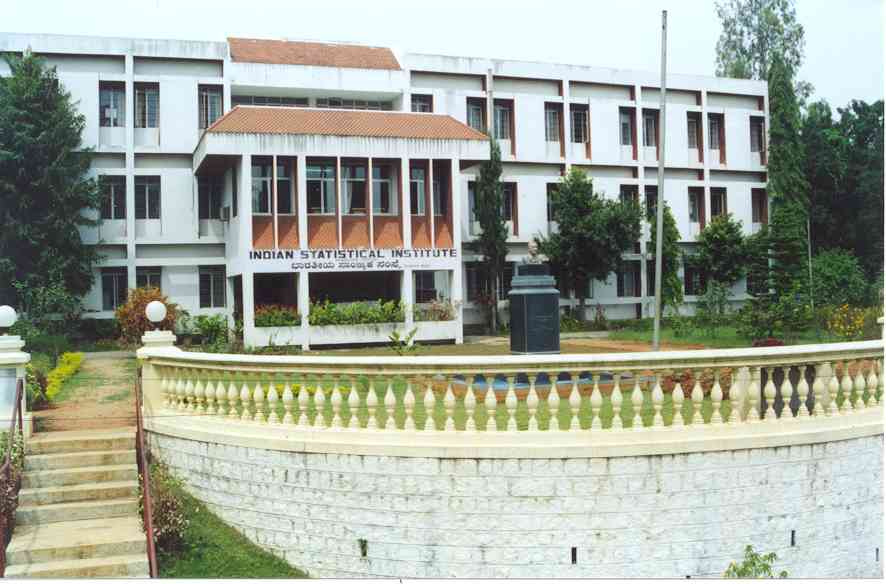 |
 |
Bangalore Probability Seminar 2014
Venue: Indian Statistical Institute (auditorium) and Indian Institute of Science (Mathematics dept)
Organizers: Siva Athreya and Manjunath Krishnapur
|

|
|
24 Nov, IISc, 2:00 PM
|
Optimal differentiation on arbitrary grids
|
Divakar Viswanath (University of Michigan)
|
Finite difference formulas approximate the derivatives of a function given its values at a discrete set of grid points. Much of the theory for choosing grid points is concerned with discretization errors and rounding errors are ignored completely. However, when the grids become fine the rounding errors dominate. Finding finite difference formulas which optimize the total error leads to a combinatorial optimization problem with a large search space. In this talk, we will describe a random walk based strategy for tackling the combinatorial optimization problem.
|
|
24 Nov, IISc, 3:15 PM
|
An anti-concentration inequality
|
Manjunath Krishnapur (IISc, Bangalore)
|
We give a quick overview of some recent developments (mostly of others) in the study of zeros of random polynomials and a new anti-concentration inequality that has been discovered in this context. The goal will be to give a full proof of this inequality.
|
|
27 Oct, ISI, 2:00 PM
|
Correlations in the multispecies exclusion process
|
Arvind Ayyer (IISc, Bangalore)
|
The multispecies exclusion process on Z/nZ is a stochastic process where each site i (i=1,...,n) is occupied by a particle of a certain species and neighbouring particles exchange with rates depending on the
relative values of their species. A special case of this process turned up in the study of a natural random walk on an affine Weyl group by Thomas Lam, where he conjectured a formula for the limiting direction of this
walk. We prove this conjecture by looking at correlations in the multispecies exclusion process. Time permitting, several generalisations will be discussed.
This is joint work with Svante Linusson.
|
|
27 Oct, ISI, 3:15 PM
|
How to Infect a Network from the Outside
|
Aditya Gopalan (IISc, Bangalore)
|
We study epidemic infection processes in networks when the spread is
assisted by a relatively small number of `external agents' --
infection sources with bounded spreading power, but whose movement is
unrestricted with regard to the underlying network topology. This is
motivated by real-world settings in which spreading processes occur at
two distinct time-scales -- local or diffusive spread following
neighbouring nodes, and global or extrinsic spread due to long-range
virulence, e.g., contagious biological diseases aided by long-range
modes of transport, smartphone worms exploiting both short-range
(Bluetooth) and long-range (Internet/SMS) media, etc. We introduce a
generalization of the Susceptible-Infected (SI) epidemic model to
capture long-range, potentially controlled proliferation of an
otherwise locally diffusive contagion, deriving order-wise performance
bounds on the time taken to infect the entire network for simple
`random' spreading policies. Conversely, using first-passage
percolation techniques, we also establish fundamental limits on the
spread time performance of any infection-spreading algorithm for
certain common classes of spatial and random graphs. The broad upshot
is that in homogeneous, spatially constrained networks, it is enough
for an external agent to randomly spread infection in a completely
state-oblivious manner to achieve order-wise optimality of spread
time. (Joint work with Siddhartha Banerjee, Abhik Das and Sanjay
Shakkottai)
|
|
15 Sep, ISI, 2:00 PM
|
Stationary Solutions of stochastic differential equations in the space of tempered distributions
|
Suprio Bhar (ISI, Bangalore)
|
In [1] it was shown that there is an one to one correspondence between solutions of a class of finite dimensional SDEs and solutions of a class of SPDEs in $\mathcal{S}'$, the space of tempered distributions, driven by
the same Brownian Motion. There the coefficients $\bar{\sigma}, \bar{b}$ of the finite dimensional SDEs were related to the coefficients of the SPDEs in $\mathcal{S}'$ in a special way, viz. through convolution with the
initial value $y$ of the SPDEs.
In this talk, we consider the situation where the solutions of the finite dimensional SDEs are stationary and ask whether the corresponding solutions of the equations in $\mathcal{S}'$ are also stationary. We provide an
affirmative answer, when the initial random variable takes value in a certain set $\mathcal{C}$, that ensures that the coefficients of the finite dimensional SDEs are related to the coefficients of the SPDEs in the above
`special' manner.
[1] B.Rajeev, Translation invariant diffusions in the space of tempered distributions, Indian J. Pure Appl. Math. 44 (2013), no.~2, 231--258.
|
|
15 Sep, ISI, 3:15 PM
|
Minimization problems based on a parametric family of relative
entropies
|
Ashok Kumar (IISc, Bangalore)
|
We study minimization of a parametric family of relative
entropy functionals, also called $I_\alpha$-divergence or an $\alpha$-relative entropy, $\alpha >0, \alpha \neq 1$. This
$I_\alpha$-divergence is closely related to the Rényi entropy and coincides with the usual relative entropy (Kullback-Leibler divergence) as
$\alpha \rightarrow 1$. Minimization of $I_\alpha$-divergence over second argument (reverse $I_\alpha$-projection) is closely related to a parameter estimation procedure in statistics which is robust to outliers.
Motivated by the maximum Rényi entropy principle, we study minimization of $I_\alpha$-divergence over the first argument (forward $I_\alpha$-projection) on a set of probability distributions determined by linear
constraints (linear family). We prove that the minimizer comes from a family of probability distributions of power law which we call an $\alpha$-power law family. This is analogous to the fact that the minimizer of
KL-divergence comes from an exponential family. We observe an interesting duality that the robust parameter estimation on an $\alpha$-power law family, which is a reverse $I_\alpha$ -projection, can be shown to be a
forward $I_\alpha$-projection of a specific distribution on an appropriate linear family.
|
|
18 Aug, IISc, 2:00 PM
|
Asymptotic behavior of positive harmonic functions in some
unbounded domains
|
Koushik Ramachandran (ISI, Bangalore)
|
This talk will concern asymptotic estimates at infinity for
positive harmonic functions in a large class of non-smooth unbounded
domains. These are domains whose sections, after rescaling, resemble a
Lipschitz cylinder or a Lipschitz cone, e.g., various paraboloids and
horns. We will also mention a few related results in probability, e.g
harmonic measure (distribution of exit position of Brownian motion)
estimates.
|
|
18 Aug, IISc, 3:15 PM
|
Large deviations for random polynomials: exponential coefficients
|
Subhroshekhar Ghosh (Princeton university, USA)
|
We obtain a large deviations principle (in the space of probability measures on $\C$) for the empirical measure of zeroes of random polynomials with i.i.d. exponential coefficients. One of the key challenges
here is the fact that the coefficients are a.s. all positive, which enforces a growing number of non-linear constraints on the locations of the zeroes. En route, we will discuss a recent characterization theorem of
Bergweiler, Eremenko and Sokal, and its application in the proof of our main theorem.
|
|
30 Apr, IISc, 2:00 PM
|
Brownian excursions into an interval
|
B Rajeev (ISI, Bangalore)
|
The dynamics of excursions of Brownian motion into a set with
more than one boundary point , which no longer have the structure
of a Poisson process, requires an extension of Ito's excursion
theory , due to B.Maisonneuve. In this talk we provide a `bare hands'
calculation of the relevant objects - local time, excursion measure -
in the simple case of Brownian excursions
into an interval (a,b), without using the Maisonneuve theory.
We apply these computations to calculate
the asymptotic distribution of excursions into an interval, straddling
a fixed time t , as t goes to infinity.
|
|
30 Apr, IISc, 3:15 PM
|
Phase transitions in the pattern maximum likelihood problem and its Bethe variant
|
Navin Kashyap (IISc, Bangalore)
|
The pattern maximum likelihood (PML) estimate, introduced by Orlitsky et al. (2004), is an estimate of an unknown underlying probability distribution from n i.i.d. samples taken from the distribution. It is known to
perform better than the empirical frequency estimate when the number of samples, n, is much smaller than the support size of the unknown underlying distribution. The PML estimate involves solving a difficult optimization
problem over the set of all probability mass functions (pmfs) of finite support. While investigating the question of deciding when the PML estimate is a uniform distribution, we encountered an interesting phase transition
phenomenon in the PML estimate: at a certain sharp threshold, the uniform distribution goes from being a local maximum to being a local minimum for the optimization problem in the estimate. The Bethe variant of the PML
estimate, based on the Bethe approximation method from statistical physics, also exhibits an interesting phase transition behaviour. In this talk, we will describe the phase transitions seen in the PML estimate and its
Bethe variant. All the necessary background and definitions will be provided in the talk.
This is joint work with Winston Fernandes, Eric Chan and Manjunath Krishnapur.
|
|
24 Mar, ISI, 2:00 PM
|
Asymptotics of mean-field interactions in a wireless local area network
|
Rajesh Sundaresan (IISc, Bangalore)
|
Performance analysis of wireless local area networks is often done by modeling the evolving interactions between nodes as coupled Markov chains. I will highlight a continuous-time model where each chain reflects the
stochastic evolution of one node over a finite number of states. The chains are coupled through the dependence of the instantaneous transition rates on the current empirical distribution of the nodes across the different
states, also called spatial distribution. I will then discuss some asymptotic results on (1) the empirical distribution (in path space) of the nodes and (2) the flow of the spatial distribution over time, in the limit of
a large number of nodes. The asymptotics will be that of large deviations from the respective limit laws.
The talk will be based on joint work with Vivek S. Borkar(arXiv:1107.4142v2).
|
|
24 Mar, ISI, 3:15 PM
|
On the Estimation of Risk Measures using Extreme Value Theory Tools
|
Marie Kratz (ESSEC Business School, Cedex, France)
|
We develop theoretically as well as numerically a new method, Normex,
for the sum of independent heavy tailed distributed random variables, to obtain
the most accurate evaluation of its entire distribution. Normex provides sharp
results, whatever the number of summands and the tail index are. It is
particularly suited when the Central Limit Theorem applies but with slow
convergence of the mean and with a poor approximation for the tail. Hence, it is
filling up a gap in the literature by giving an appropriate limit distribution
in this case, in general better than with most standard methods. The main
motivation of this work comes from the need to evaluate the aggregated risks
distribution and risk measures when working on financial or insurance data, and
to provide practical solutions for accurately estimating high quantiles.
Properties of risk measures will also be discussed in this talk.
|
|
10 Mar, IISc, 2:00 PM
|
Synchronization Via Interacting Reinforcement
|
Neeraja Sahasrabudhe (ISI, Bangalore)
|
We consider a system of urns of Friedman-type, with balls of
two colours, such that the reinforcement of each urn depends on both
the content of that urn and the average content of all the urns. It is
known that the ratio of balls of either colour in this case converges
to $\frac{1}{2}$ with probability 1. We study the fraction of balls of each
colour in each urn $Z_t(i)$ and the average fraction $Z_t$ and obtain
the rates of convergence of Var($Z_t(i)$) and Var($Z_t$). We
will also discuss the work of Dai Pra, Minelli and Pierre-Yves Louis
on interacting Polya urns. In this case, it is shown that the urns
synchronize almost surely and a normal approximation for a large
number of urns is obtained. By synchronization we mean that the
fraction of balls of a given colour converges almost surely to the
same limit for all urns.
|
|
10 Mar, IISc, 3:15 PM
|
Duality and multidimensional ruin
|
S. Ramsubramanian (ISI, Bangalore)
|
Ruin problem for an insurance network, operating under a risk
diversifying agreement, is described in terms of a reflected random walk
in an orthant. Time reversal leads to a storage network which is another
reflected random walk. Connection between ruin probability of the
insurance network and asymptotics of the storage network is being studied
in an ongoing work.
|
|
10 Feb, IISc, 2:00 PM
|
From random matrices to long range dependence
|
Arijit Chakrabarty (ISI, Delhi)
|
Random matrices whose entries come from a stationary
Gaussian process are studied. The limiting behavior of the eigenvalues as
the size of the matrix goes to infinity is the main subject of interest in
this talk. It is shown that the limiting spectral distribution is determined by the absolutely continuous component of the spectral measure of the stationary process, a phenomenon resembling that in the situation where
the entries of the matrix are i.i.d. On the other hand, the discrete component contributes to the limiting behavior of the eigenvalues in a completely different way. Therefore, this helps to define a boundary between
short and long range dependence of a stationary Gaussian process in the context of random matrices.
This is a joint work with Rajat Hazra and Deepayan Sarkar.
|
|
10 Feb, IISc, 3:15 PM
|
On weak universality for directed polymers
|
Konstantin Khanin (University of Toronto)
|
The talk is based on a joint paper with T.Alberts and J.Quastel.
We consider directed polymers in a random environment. However the inverse temperature is scaled with the length of a polymer. It turn out that with a proper critical scaling one can get a nontrivial universal behaviour
for the partition function and the end point distribution. Moreover the limiting partition function distribution asymptotically converges to the Tracy-Widom law as the rescaled inverse temperature tends to infinity.
|
|

